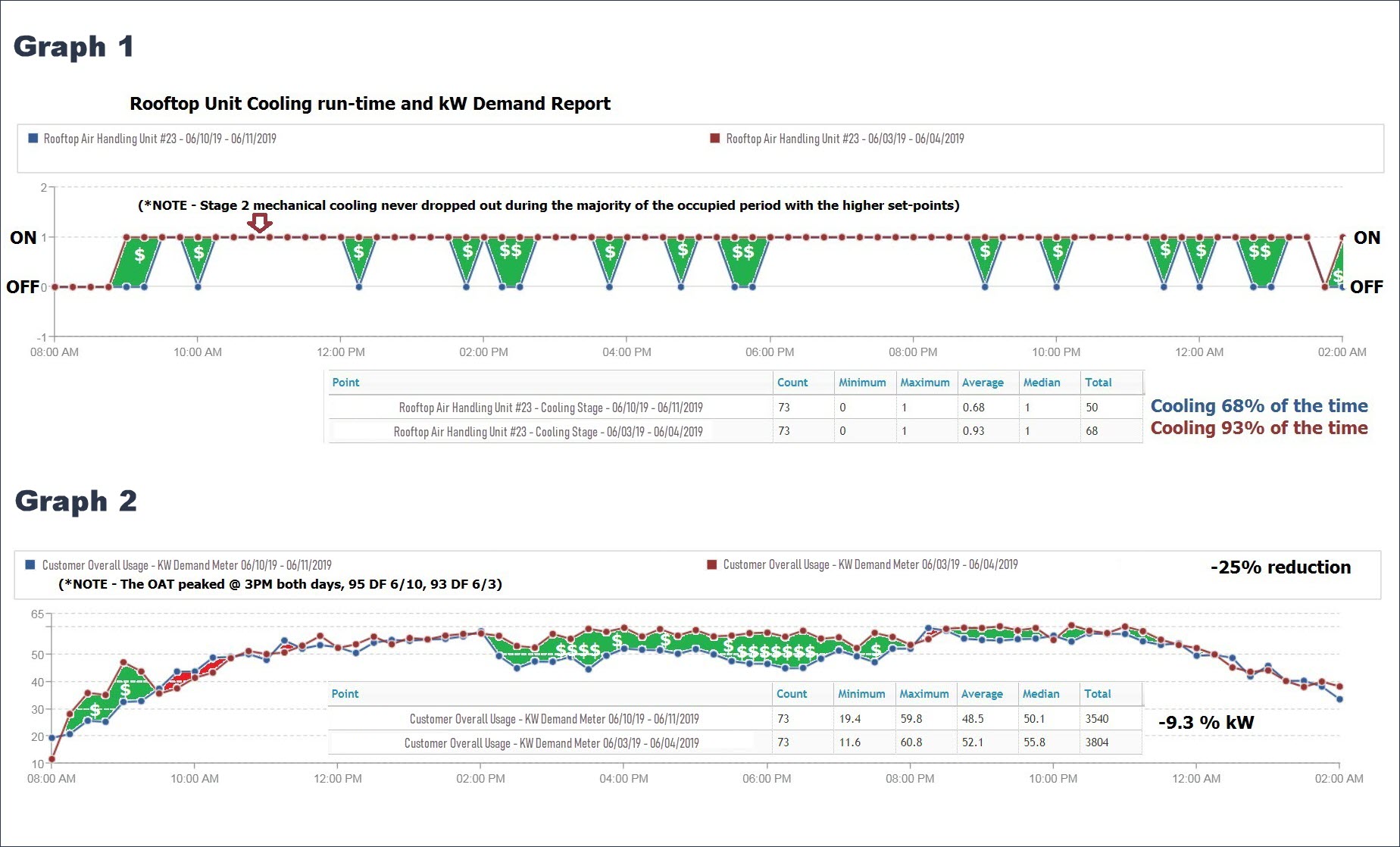Share this
Building as a Battery - Using a Building’s Thermal Mass for Efficient Energy Management
by Phoenix Energy Technologies on Jul 29, 2019
 Efficient energy usage has been, and continues to be, one of the hottest topics in the building management industry. Each year, businesses spend tens of billions of dollars on power consumption operating lights, computer equipment, process equipment, and HVAC.
Efficient energy usage has been, and continues to be, one of the hottest topics in the building management industry. Each year, businesses spend tens of billions of dollars on power consumption operating lights, computer equipment, process equipment, and HVAC.
HVAC typically accounts for the highest percentage of the utility costs for most commercial buildings. Data from the hospitality industry, for example, indicates that hotels spend in excess of $2,000 per room on energy costs annually and 40 percent of those costs are directly attributable to HVAC.
Technology has made the management of heating and cooling systems more effective through the automatic adjustment of system settings based on any number of inputs such as the weather or occupancy levels. The wide deployment of networking and computer systems has made the use of technology even easier, allowing the control of HVAC systems remotely, even from the other side of the globe.
The use of management technology is a viable solution to the problem of environmental comfort system efficiency. However, there is an even simpler solution that will make a noticeable difference - using the thermal mass of the building.
What is Thermal Mass?
Thermal mass is essentially the capacity of a building to store heat. It effectively provides resistance to large temperature fluctuations and it can be used to more efficiently run HVAC systems. The majority of modern buildings are designed to operate at an internal temperature of 72 degrees Fahrenheit. Further, the environmental controls of a building are normally designed to be "balanced" at an external temperature of 65 degrees Fahrenheit, which means that the HVAC system does not need to operate to maintain an internal temperature of 72 on a 65 degree day.
How Do You Use It?
Let's consider a real-world example of using thermal mass to increase the efficiency of an HVAC system. Like many commercial buildings, this facility ran at what logically seemed to be the best setpoints. During the day, while it was occupied, the building operated at approximately 75 degrees and at night, while it was unoccupied, the building operated at approximately 80 degrees. Most building managers would agree that this is a standard practice for commercial HVAC units.
Despite the settings, the HVAC unit operated nearly constantly for 16 hours per day. While a little counterintuitive, the higher set points were actually the problem. The 80 degree nighttime setpoint allowed the building to get too hot. Once the building was occupied, the heat load was too great for the unit to handle and the setpoint was never reached. The solution was simple, if a little counterintuitive. The setpoint needed to be reduced to 72 degrees.
Adaptive Energy Management - How to Use Your Buildings as a Battery
Results
Graph 1 below shows the operational state of the unit before and after the setpoint reduction. The red trace indicates the runtime at the original setting. As you can see, the unit was operating for an incredible 93 percent of the time. The blue trace indicates the "on" time at the new setpoint. Now the unit is only operating 68 percent of the time - a 25 percent overall reduction by simply using the thermal mass of the building.

Graph 2 above shows power usage in kilowatts. The colors are the same for the settings and the results are clear. The new, cooler setting caused a reduction in power consumption of just over 9 percent. The key takeaway from this data is the monetary savings, shown in green, that will result by running the building at a lower setpoint.
Finally, the overall power consumption is shown in Graph 3 below. As you can see, the overall power consumption dropped considerably at 72 degrees, once the building reached equilibrium.

As you can see, making your HVAC more efficient can really be very simple if it is operated as it was designed. While the most immediate impact will be shown on your monthly utility bill, there are other long-term benefits that have financial implications. Lower maintenance and repair costs, lower capital equipment expenditures, and more comfortable working conditions are just a few of the advantages that will result from taking advantage of your building's thermal mass.
For information on the key types of building management technologies that help manage thermal mass, please see below.
Related Posts
What Facility Managers Need to Know About Load Shifting - Part 1
Adaptive Energy Management Guide
Are You Managing Your Energy Spend?
4 Common Myths of Energy Conservation in Building Management
Precision Building Management: Understanding Closed Loop Control
Share this
- Facilities Management (90)
- Energy Management (69)
- Company News (49)
- Smart Buildings (37)
- Retail (36)
- Building Management (24)
- Building Automation Systems (21)
- Energy Demand Management (19)
- Sustainability (19)
- EEI (15)
- Adaptive Energy Management (14)
- Grocery (14)
- demand response (14)
- Artificial Intelligence (12)
- Data Integration and Visibility (10)
- HVAC IQ (9)
- COVID-19 (8)
- Customer Spotlight (8)
- Carbon Management (7)
- Setpoints and Temperatures (7)
- Equipment Maintenance (6)
- Operational Efficiency (6)
- Ask Ron (5)
- Asset Manager (5)
- Finance and Procurement (5)
- IoT and Digital Transformation (5)
- Refrigeration Optimization (5)
- Awards (4)
- Comfort (4)
- Energy & Store Development (4)
- Safety and Compliance (4)
- Demand Charge Management (3)
- Energy Management System (3)
- Premium Services (3)
- Automated Demand Response (2)
- ConnexFM (2)
- Customer Service (2)
- HVAC Vendor Management (2)
- Lifecycle Asset Management (2)
- Load Shedding (2)
- Refrigeration IQ (2)
- Technician View (2)
- Analytics (1)
- Data (1)
- Data Integration and Visualization (1)
- EMS (1)
- Knowledge Center (1)
- OSHA (1)
- asset management (1)
- November 2025 (1)
- October 2025 (2)
- September 2025 (1)
- August 2025 (3)
- July 2025 (1)
- June 2025 (1)
- May 2025 (2)
- March 2025 (2)
- February 2025 (1)
- January 2025 (2)
- December 2024 (2)
- October 2024 (1)
- September 2024 (1)
- August 2024 (2)
- June 2024 (2)
- April 2024 (2)
- March 2024 (2)
- January 2024 (1)
- December 2023 (1)
- October 2023 (2)
- September 2023 (2)
- August 2023 (2)
- July 2023 (1)
- May 2023 (2)
- April 2023 (2)
- March 2023 (3)
- February 2023 (1)
- January 2023 (1)
- December 2022 (1)
- November 2022 (2)
- October 2022 (2)
- September 2022 (1)
- May 2022 (2)
- April 2022 (1)
- March 2022 (3)
- February 2022 (2)
- January 2022 (4)
- December 2021 (2)
- November 2021 (3)
- October 2021 (1)
- September 2021 (3)
- August 2021 (4)
- July 2021 (1)
- June 2021 (2)
- May 2021 (1)
- January 2021 (2)
- December 2020 (2)
- November 2020 (2)
- October 2020 (3)
- September 2020 (4)
- August 2020 (3)
- July 2020 (2)
- June 2020 (3)
- May 2020 (3)
- April 2020 (5)
- March 2020 (5)
- February 2020 (4)
- January 2020 (4)
- December 2019 (4)
- November 2019 (3)
- October 2019 (4)
- September 2019 (5)
- August 2019 (4)
- July 2019 (4)
- May 2019 (2)
- April 2019 (3)
- February 2019 (1)
- December 2018 (1)
- November 2018 (1)
- October 2018 (3)
- September 2018 (3)
- August 2018 (3)
- July 2018 (3)
- June 2018 (3)
- May 2018 (1)
- June 2015 (1)
- March 2013 (1)
- January 2013 (1)
- December 2011 (1)
- October 2011 (1)
- September 2011 (1)



